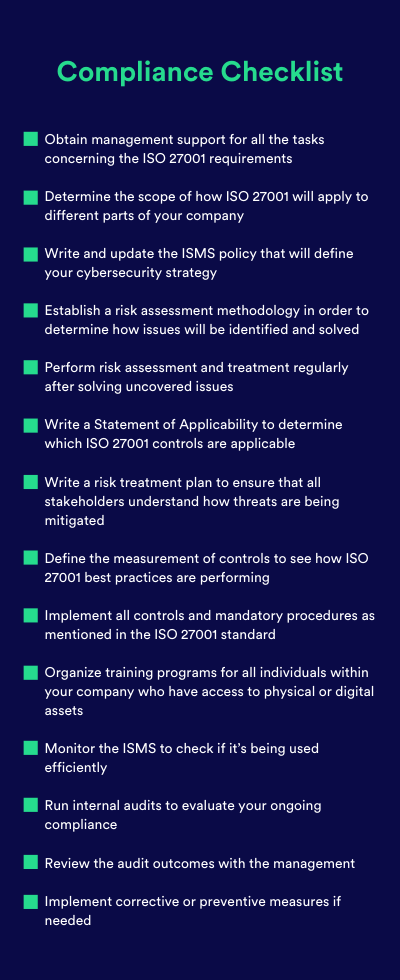What does it mean to be an ISO 27001-certified business?

When it comes to choosing a data center partner, security is always top of mind.
The continuous development of technology brought a lot of advantages to companies all over the world, but also acted as highly attractive bait for attackers trying to get unauthorized access to these advanced technological systems.
In the last years, many cyber-attacks in the form of DDOS (Distributed Denial of Service) attacks have affected both the companies and the customers who rely upon their services.
One of the largest and recent attacks was aimed at GitHub in 2018. A popular online code management service used by millions of developers, GitHub is used to high traffic and usage. What it wasn’t prepared for was the then record-breaking 1.3 Tbps of traffic that flooded its servers with 126.9 million packets of data each second.
In a world where this kind of attacks are becoming more massive in scale and more sophisticated in nature, how can a company protect its digital assets successfully?
What is ISO 27001?
Here's where the information security management systems (ISMS) standard ISO 27001 comes in.
The ISO 27001 standard defines the requirements for establishing, implementing, maintaining and continually improving an information security management system within the context of a company.
It also includes requirements for the assessment and treatment of information security risks that could affect that business.
What is the ISO 27001 certification, and what are its main benefits?
Looking for a way to be always ready to respond to the ever-evolving threat landscape that the digital space presents?
This might depend on one business choice: making sure that your data center is ISO 27001 certified.
Below are the main reasons why you should consider getting the ISO 27001 certification.
1. Avoid data breaches.
Every business depends on the security of their information. This is where your company’s documents, client data, and personally identifiable information lies. If any of this information is leaked, it can lead to great financial losses and also, can greatly damage your public image. In this case, ISO 27001 will ensure that your ISMS is as effective as possible by using a methodical and proven approach.
2. Build customer trust.
As ISO 27001 is a challenging standard covering a broad scope of requirements, not every company chooses to get certified. Nonetheless, those businesses that have achieved certification are the ones who take cybersecurity seriously enough to have undergone comprehensive testing for their safety procedures. Considering the growing number of cyberattacks in recent years, this can be a great reassurance for existing and potential customers.
3. Gain a competitive advantage.
The ISO 27001 certification is internationally recognized and can give you an advantage over competitors that aren’t in compliance.
4. Avoid costly fines.
Data breaches generally involve legal penalties, reparation costs, and lost sales, all this amounting to great sums of millions of dollars for medium- to big-sized companies. By preventing breaches from happening from the start, your business can avoid these costs and focus on growing.
5. Facilitate compliance with data privacy laws.
Complying with the requirements of the ISO 27001 standard will give you a significant advantage in your compliance efforts for regulations such as EU General Data Protection Regulation (GDPR) and California Consumer Privacy Act (CCPA).
How to get an ISO 27001 certification
Receiving an ISO 27001 certification is a lengthy process that requires significant involvement from both internal and external stakeholders.
In short, the ISO 27001 certification process can be broken down into three stages.
The 3 stages of ISO 27001 certification
- The company hires a certification body who then conducts a basic review of the ISMS to look for the main forms of documentation.
- The certification body performs a more comprehensive audit of the company’s ISMS and controls supporting the 14 control objectives and related controls referenced in Annex A to see whether policies and procedures are being followed appropriately.
- Follow-up audits are scheduled between the certification body and the company to ensure compliance with the standard is maintained.
What are the ISO 27001 Audit Controls?
The ISO 27001 documentation divides best practices into 14 separate controls. Certification audits will cover controls from each one during compliance checks.
Here's what these ISO 27001 controls refer to:
- Information Security Policies: covers how policies should be documented in the ISMS and reviewed for compliance.
- Organization of Information Security: describes the responsibilities of each part of the company.
- Human Resource Security: involves the efficiency of onboarding and off-boarding procedures.
- Asset Management: describes the processes concerning data assets management and how they should be protected and secured.
- Access Control: provides guidance on how access privileges are established and who is responsible for maintaining them.
- Cryptography: includes the best practices in encrypting sensitive data.
- Physical and Environmental Security: describes the processes for securing buildings and internal equipment.
- Operations Security: explains how to collect and store data securely.
- Communications Security: provides an overview of what communication systems are used in the company’s workflow and how the data is kept secure.
- System Acquisition, Development, and Maintenance: concerns the processes for managing systems in a secure environment.
- Supplier Relationships: details how a company should interact with third parties while maintaining security.
- Information Security Incident Management: refers to the best practices used for mitigating security issues.
- Information Security Aspects of Business Continuity Management: explains how to handle business disruptions and major changes.
- Compliance: identifies what government or industry regulations are relevant to that specific business.
Compliance is a process, not a one-time deal
Achieving the ISO 27001 certification is just the first step to being fully compliant (see our guide to Regulatory Compliance here). It’s essential to also maintain these high standards and best practices after the audit has been completed.
Management should make sure that their employees don’t lose their diligence when it comes to meeting those requirements intended for a secure system.
Moreover, considering how often new employees join a company, that organization should hold training sessions to boost their understanding of the ISMS and how it’s used.
Existing employees should also be required to pass a yearly test to refresh their knowledge of the main goals of the ISO 27001.
It is recommended to perform your own ISO 27001 internal audits once every three years. Nevertheless, many cybersecurity experts consider that only by having an internal audit every year you can aspire to keep ahead of any threats that might appear in the rapidly changing world of cyber.
Compliance checklist
Take a look at the below compliance checklist (download here) to see how you should approach the ISO 27001 compliance strategy:

As more and more aspects of our lives become digitized, it’s reassuring to know that there are actionable information security standards set in place to help keep your data safe.
How a visitor management system (VMS) can help you become ISO 27001 certified
The way the ISO 27001 framework is written, it does not mandate how you must achieve its principles explicitly. As an organization, you’re free to interpret how to best meet the requirements of an ISMS and the associated ISO 27001 certification.
While setting up your ISMS, you will encounter many security and privacy driven domains. Along the way, you will have to prove you can manage every one of these domain’s inherent risks.
There’s plenty of domains and requirements where a VMS can save you lots of headaches.
It will, amongst others:
- Help you enforce your Information Security Policy (5.2)
- Help you address risks and opportunities (6.1)
- Help you document the people flows on your premises (7.5)
- Demonstrate physical access related operational planning and controls (8.1)
- Add to your treatment of physical access related risks (8.3)
- Allow you to perform an internal audit of physical access controls & environmental security (9.2)
- Enable you to detect non-conformity of physical access controls (10.1)
And it doesn’t have to stop there.
A VMS like Proxyclick is built with security and privacy controls by design. You can leverage many ready-to-go functionalities to work your way into full confidence in your physical access controls in place for visitors, contractors and employees.
Go forth and become compliant
Having the right cloud-based visitor management system at your side during the compliance journey is proven to reduce the stress and boost the security of your data, so you can get on with the business at hand.
Ready to test this theory?
Learn more about Proxyclick’s security measures, or book a call with one of our experts now.



